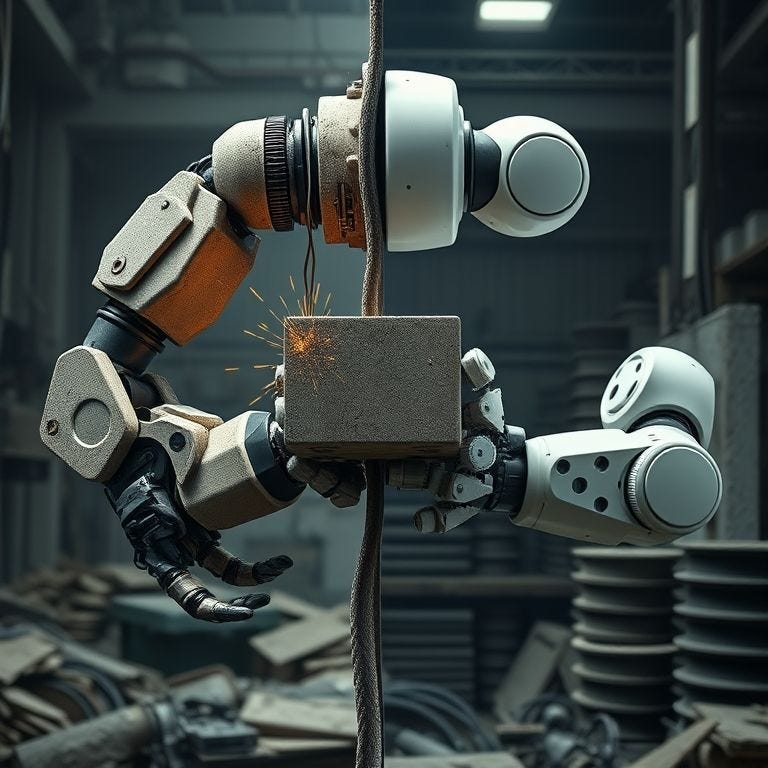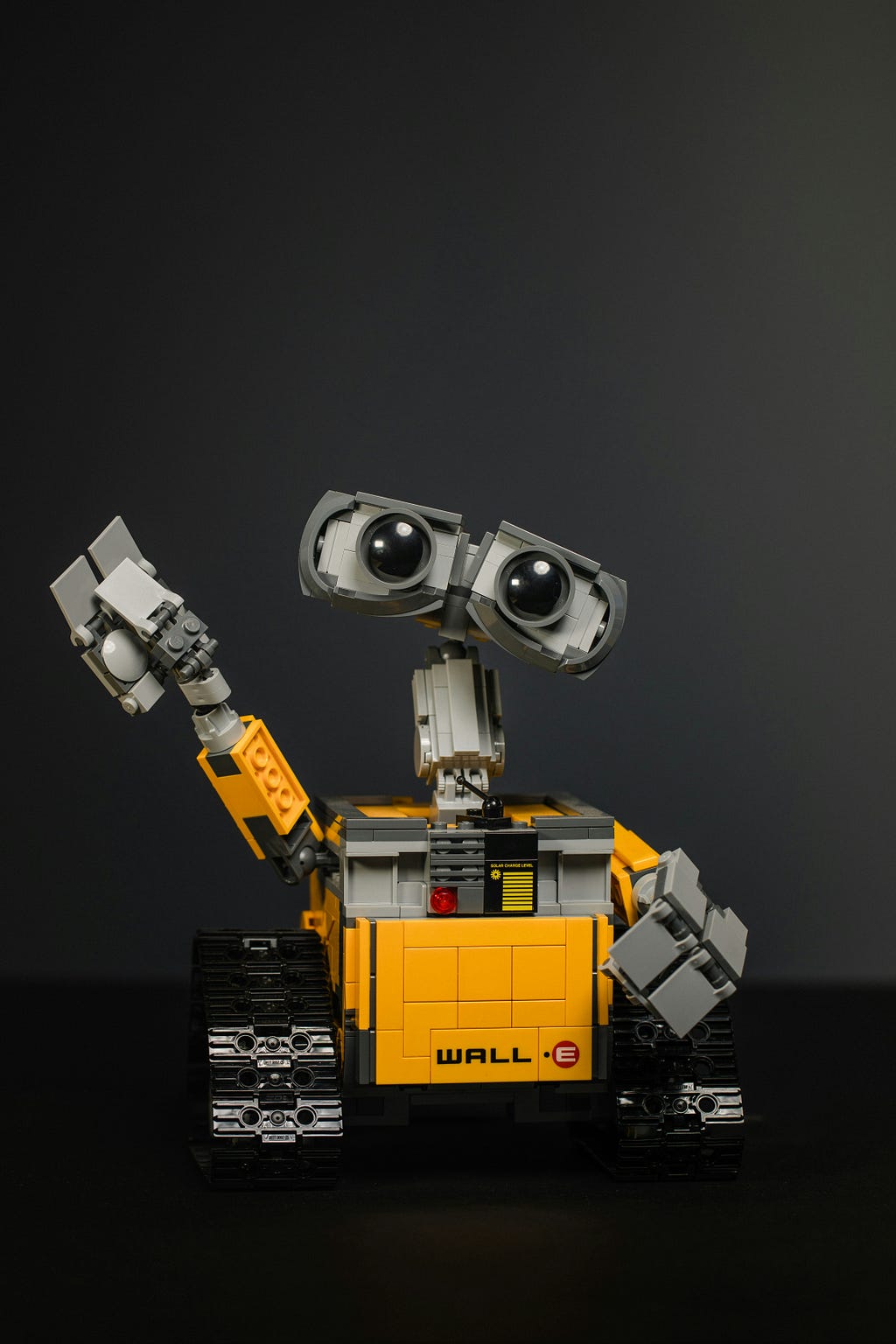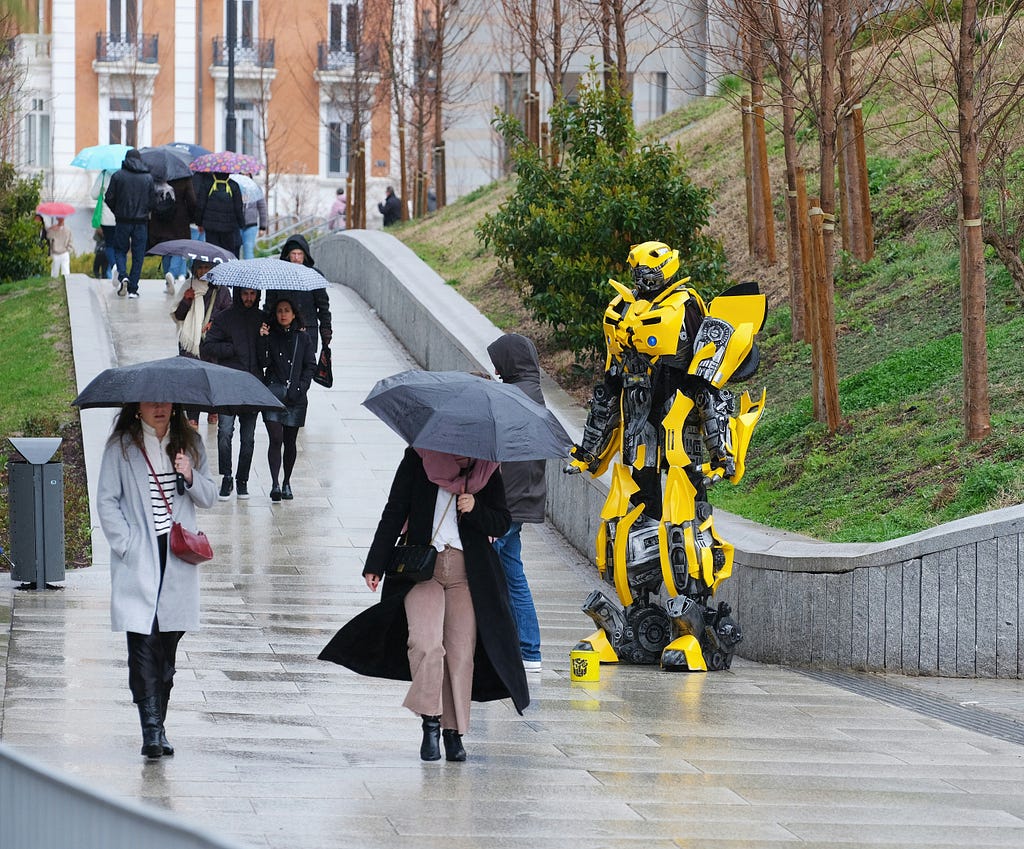This content originally appeared on Level Up Coding – Medium and was authored by Akhilesh Yadav
Beyond the Hype: True Intelligence for Robotics is Finally Here.
The Unseen Battle: How Your Robots Are Still Stuck in the Stone Age (And How Gemini ER 1.5 is Ending It)

Tired of brittle, hard-coded robot behaviors? Discover how Gemini Robotics ER 1.5 empowers your projects with adaptive, human-like intelligence, transforming impossibility into innovation.
I remember the early days of building robot manipulators. Hours, sometimes days, spent meticulously crafting inverse kinematics solutions, fine-tuning path planning algorithms, and wrestling with sensor fusion. The joy of seeing a robot precisely pick up a specific object from a known location was immense — a testament to countless lines of code and mathematical rigor.
But then came the inevitable: a slight change in the object’s position, a different lighting condition, or an unexpected obstacle. And just like that, our beautifully engineered “intelligent” machine would freeze, flail, or simply give up. It felt like we were building incredibly sophisticated tools for a world that never changed, while the real world laughed at our efforts. Sound familiar? If you’re an AI Engineer dabbling in robotics, you’ve probably felt that frustration deep in your bones. The promise of intelligent robots often clashes with the harsh reality of their rigid, context-blind operations.
That’s the unseen battle most of us are fighting: pushing the boundaries of robotics with traditional methods that are inherently limited. We’ve been teaching robots like children learning to recite facts — impressive when the questions match, but utterly lost when faced with novelty.
Why Traditional Robotics Falls Short
Before we dive into the game-changer, let’s candidly acknowledge the limitations that have plagued robotics for decades.
Traditional robotics, while forming the bedrock of industrial automation, operates on a fundamentally different paradigm than what we envision for truly intelligent agents. It’s often:
- Rule-Based and Brittle: Every action, every decision, needs to be explicitly programmed. Imagine writing code for every possible permutation of an object’s position, orientation, and material properties. It’s an engineer’s nightmare! A minor deviation means a system failure.
- Environment-Dependent: These systems thrive in structured, predictable environments like assembly lines where variables are tightly controlled. Introduce an unstructured environment — say, a cluttered warehouse or a dynamic surgical theatre — and they struggle immensely.
- Computationally Intensive for Novelty: Adapting to new tasks or unforeseen circumstances requires significant re-programming and re-calibration, making scalability and generalization a massive headache.
- Single-Modal Perception: Often relying on a single sensor type (e.g., vision) or limited fusion, these robots lack a holistic understanding of their environment, missing crucial cues that humans take for granted.
Consider a simple task: picking up a cup. A traditional robot might need to know the cup’s exact 3D coordinates, its grip points, and a pre-programmed motion trajectory. If the cup is slightly rotated, or if a hand is in the way, the system breaks.

This is where the magic of AI, particularly foundation models, enters the arena. We’re moving from explicitly telling robots how to do something, to showing them what to achieve and letting them figure out the how.
Enter Gemini Robotics ER 1.5: A New Era of Embodied Intelligence
This brings us to the exciting breakthrough: Gemini Robotics ER 1.5. This isn’t just another incremental update; it’s a paradigm shift in how we approach robot control and intelligence. Built on the powerful Gemini architecture, ER 1.5 brings advanced multimodal understanding and reasoning capabilities directly to the robotic domain.
Think of it as giving your robot a significant chunk of common sense and the ability to learn from the world, rather than just executing predefined scripts.
What Makes ER 1.5 a Game-Changer?
Gemini Robotics ER 1.5, in essence, is an AI model designed to provide robots with a more sophisticated understanding of their environment and tasks. Here’s a quick rundown of its core capabilities:
- Multimodal Perception & Fusion: Unlike traditional systems that might only process vision, ER 1.5 integrates data from various sensory inputs — vision, haptics (touch), audio, and proprioception (body awareness). This allows robots to understand context more deeply, discerning not just what an object looks like, but also how it feels and sounds when interacted with. Imagine a robot knowing a glass is fragile just by touching it, or that a screw is loose by the sound it makes.
- Generalization & Adaptation: This is where the rubber meets the road. ER 1.5 is engineered for robust generalization. Trained on vast datasets of real-world interactions and simulations, it can transfer learned skills to entirely new, unseen scenarios or objects with minimal retraining. This drastically reduces development time and increases the robot’s versatility.
- Complex Task Reasoning: ER 1.5 moves beyond simple pick-and-place. It can understand and execute multi-step instructions, infer sub-goals, and plan sequences of actions in a human-like manner. This opens doors for robots to perform more intricate tasks, from assembling complex machinery to assisting in delicate procedures.
- Improved Human-Robot Interaction (HRI): By understanding human intent better through observation and natural language, ER 1.5 can facilitate more intuitive collaboration. Imagine verbally instructing a robot to “clean up the workshop” and having it intelligently assess the mess and execute the task.

While Gemini ER 1.5 represents a significant leap, it’s essential to understand its position in the broader AI robotics landscape.
Traditional Robotics (Rule-Based):
- Pros: High precision for repetitive, well-defined tasks; robust in static environments.
- Cons: Extremely brittle to changes; poor generalization; difficult to program for complex or novel tasks.
- Use Cases: Automotive assembly lines, highly controlled manufacturing.
Other AI/ML Models in Robotics (e.g., specific vision models, reinforcement learning for specific skills):
- Pros: Can learn complex patterns; some level of adaptation for trained tasks.
- Cons: Often single-modal; requires extensive task-specific data; struggles with broad generalization; “catastrophic forgetting” is common.
- Examples: DeepMind’s AlphaGo (game AI, but principles apply), early RL for locomotion.
Foundation Models for Robotics (Like Google’s RT-X models, OpenAI’s robotics initiatives):
- Pros: Large-scale pre-training on diverse data; impressive generalization across tasks and embodiments; multimodal capabilities.
- Cons: High computational cost for training; still an active research area; integration can be complex.
- Gemini ER 1.5’s Edge: Leverages the advanced multimodal reasoning and long-context understanding of the core Gemini model, pushing the boundaries of generalization, human-robot collaboration, and complex task decomposition in real-world scenarios. Its emphasis on safety and robust deployment in varied environments is a key differentiator.
Integrating ER 1.5 into Your Projects: A Practical Guide for AI Engineers
So, you’re convinced ER 1.5 is the future. How do you, an AI Engineer, actually get your hands dirty and integrate this powerhouse into your next robotics project? The good news is that the focus is on developer-friendly integration.
1. The API/SDK Approach: Your Gateway to Intelligence
The primary method for integration will be through a robust API (Application Programming Interface) and a well-documented SDK (Software Development Kit). Expect Python-centric libraries, as it’s the lingua franca of AI and robotics development.
- Perception Modules: Send raw sensor data (camera feeds, depth maps, haptic sensor readings, audio streams) to ER 1.5’s perception API. The model will return semantic understanding: object detection, scene graphs, material properties, human pose estimation, and even inferred human intent.
- Action & Planning APIs: Once ER 1.5 understands the world, you can query it for action recommendations or task plans. Provide a high-level goal (“Assemble the widget,” “Clean the table”), and ER 1.5 can generate a sequence of low-level robot actions or even provide joint-level commands, allowing your robot to execute.
- Learning from Demonstration (LfD): One of the most powerful features! Instead of programming, you can physically guide the robot or provide video demonstrations of a task. ER 1.5 observes and learns the underlying policy, making it incredibly fast to teach new skills.
2. Key Integration Steps: A Mental Walkthrough
- Environment Setup: Install the ER 1.5 SDK, configure authentication, and set up your robot’s communication interface (ROS, MoveIt, custom control loops).
- Sensor Stream Integration: Ensure your robot’s cameras, force sensors, and other inputs are correctly interfaced to feed data to the ER 1.5 perception API. This usually involves defining data formats (e.g., image resolutions, point cloud structures).
- Task Definition: Clearly define the task you want the robot to perform, whether through natural language prompts or structured goal definitions.
- Policy Query & Execution:
- Perceive: Send current sensor readings to ER 1.5.
- Reason & Plan: ER 1.5 processes the input, understands the state, and generates a recommended action or plan.
- Act: Convert ER 1.5’s output (e.g., desired end-effector pose, joint velocities) into commands for your robot’s low-level controller.
- Feedback Loop: Continuously update ER 1.5 with new sensor readings after each action, allowing it to adapt and refine its behavior.
Human-in-the-Loop: Design interfaces for human oversight, intervention, and correction, especially during initial deployment and for safety-critical applications.
3. Real-World Project Ideas for AI Engineers:
- Adaptive Manufacturing: Instead of fixed assembly lines, deploy robots that can adapt to variations in parts, handle unexpected errors, and perform diverse assembly tasks without re-programming.
- Logistics & Warehousing: Robots that can intelligently sort, pack, and retrieve items from unstructured piles, adapting to new inventory and unpredictable layouts.
- Service Robotics: Develop intelligent assistants for homes, hospitals, or offices that can understand complex commands, perform household chores, or provide patient support with empathy and dexterity.
- Exploration & Inspection: Autonomous robots for hazardous environments (e.g., nuclear plants, deep sea, space) that can navigate, inspect, and perform maintenance with minimal human intervention, adapting to unpredictable terrains and unforeseen challenges.
- Human-Robot Collaboration: Imagine a robot that can truly assist a surgeon, anticipate their needs, and hand over instruments with precision and foresight, learning from the surgeon’s movements.
Results and Insights: What We Can Expect
With Gemini Robotics ER 1.5, we’re not just getting better robots; we’re getting smarter collaborators.
- Accelerated Development Cycles: The ability to generalize and learn from demonstration dramatically cuts down on the time and expertise required to deploy new robotic applications.
- Unlocking New Domains: Tasks previously deemed too complex, too unpredictable, or too expensive for robots are now within reach. Think beyond factories into healthcare, agriculture, and even creative industries.
- Enhanced Safety and Robustness: By understanding context and predicting outcomes better, ER 1.5-powered robots can operate more safely in human environments, reducing collisions and improving reliability.
- True Autonomy: We’re moving closer to robots that can operate for extended periods, adapting to environmental changes and learning from experience, requiring less direct human oversight.
Limitations
While incredibly powerful, ER 1.5 is not a magic bullet. As a transparent AI engineer, I believe in being honest about the challenges.
- Computational Cost: Running such a sophisticated model on a robot in real-time still requires significant computational resources. Edge deployment remains a challenge, though continuous optimization is key.
- Data Scarcity for Niche Tasks: While ER 1.5 generalizes well, highly specialized tasks might still require some task-specific data collection and fine-tuning.
- Ethical Considerations: As robots become more intelligent and autonomous, the ethical implications become more pronounced. Who is responsible for a robot’s actions? How do we ensure fairness and prevent misuse? These aren’t just philosophical questions; they require technical guardrails.
- The “Black Box” Problem: While we can observe ER 1.5’s outputs, fully understanding its internal decision-making process for every single action remains a research frontier. Interpretability is crucial for trust and debugging.
- Real-World vs. Simulation: Bridging the “sim-to-real” gap perfectly is still an ongoing challenge. While ER 1.5 handles real-world variations well, ensuring seamless transfer from simulation training to physical deployment always requires careful validation.
Open Questions and the Road Ahead
The open questions are exciting: Can ER 1.5 learn purely from raw human video demonstrations? How can we make these models even more energy-efficient for long-term deployment? Can we imbue them with truly proactive, anticipatory intelligence?
Conclusion: The Future is Embodied, Intelligent, and Collaborative
We’ve been building robots that are marvels of engineering, but often slaves to their code. Gemini Robotics ER 1.5 fundamentally changes this narrative. It’s about empowering our robotic creations with a deeper understanding of the world, fostering genuine adaptability, and paving the way for truly collaborative human-robot ecosystems.
As AI engineers, this is our moment to shape the future of robotics. The tools are becoming increasingly sophisticated, allowing us to focus less on the tedious mechanics and more on the grand challenges of intelligence, interaction, and impact. The unseen battle against rigidity is ending, and the era of truly intelligent, embodied agents is upon us. Are you ready to build it?
Acknowledgements:
This post draws inspiration from the groundbreaking work in foundation models for robotics by teams at Google DeepMind and other leading AI research institutions. Concepts around multimodal learning and generalization owe a debt to countless arXiv preprints and research papers exploring large-scale models. Diagrams would be crafted using tools like Canva.
What are your thoughts on Gemini ER 1.5 and the future of AI in robotics? Have you encountered similar frustrations with traditional methods? Share your insights and experiences in the comments below!
The Unseen Battle: How Your Robots Are Still Stuck in the Stone Age (And How Gemini ER 1.5 was originally published in Level Up Coding on Medium, where people are continuing the conversation by highlighting and responding to this story.
This content originally appeared on Level Up Coding – Medium and was authored by Akhilesh Yadav